TimTaiLieu.vn - Tài liệu, ebook, giáo trình, đồ án, luận văn
Tổng hợp tất cả tài liệu, ebook, giáo trình Tài Chính Tiền Tệ chọn lọc và hay nhất.

 Bài giảng Financial Management - Chapter 22: Convertibles, Exchangeables, and Warrants
Bài giảng Financial Management - Chapter 22: Convertibles, Exchangeables, and WarrantsAfter Studying Chapter 22, you should be able to: Describe the features of three common types of options that may be used by firms in their financing– the convertible security, the exchangeable bond, and the warrant. Understand why these securities with option features may be attractive for a firm's long-term financing needs. Explain the diffe...
 29 trang | Chia sẻ: nguyenlinh90 | Ngày: 20/07/2019 | Lượt xem: 974 | Lượt tải: 0
29 trang | Chia sẻ: nguyenlinh90 | Ngày: 20/07/2019 | Lượt xem: 974 | Lượt tải: 0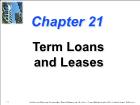 Bài giảng Financial Management - Chapter 21: Term Loans and Leases
Bài giảng Financial Management - Chapter 21: Term Loans and LeasesAfter Studying Chapter 21, you should be able to: Describe various types of term loans and discuss the costs and benefits of each. Discuss the nature and the content of loan agreements, including protective (restrictive) covenants. Discuss the sources and types of equipment financing. Understand and explain lease financing in its various form...
 38 trang | Chia sẻ: nguyenlinh90 | Ngày: 20/07/2019 | Lượt xem: 1017 | Lượt tải: 0
38 trang | Chia sẻ: nguyenlinh90 | Ngày: 20/07/2019 | Lượt xem: 1017 | Lượt tải: 0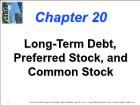 Bài giảng Financial Management - Chapter 20: Long-Term Debt, Preferred Stock, and Common Stock
Bài giảng Financial Management - Chapter 20: Long-Term Debt, Preferred Stock, and Common StockAfter Studying Chapter 20, you should be able to: Understand the terminology and characteristics of bonds, preferred stock, and common stock. Explain how the retirement (repayment) of bonds and preferred stock may be accomplished in a number of different ways. Explain the differences between various types of long-term securities in terms of cla...
 44 trang | Chia sẻ: nguyenlinh90 | Ngày: 20/07/2019 | Lượt xem: 1227 | Lượt tải: 0
44 trang | Chia sẻ: nguyenlinh90 | Ngày: 20/07/2019 | Lượt xem: 1227 | Lượt tải: 0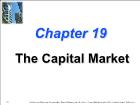 Bài giảng Financial Management - Chapter 19: The Capital Market
Bài giảng Financial Management - Chapter 19: The Capital MarketAfter Studying Chapter 19, you should be able to: Understand the characteristics of the capital market and the difference between a primary and a secondary market. Describe the three primary methods used by companies to raise external long-term funds – public issue, privileged subscription, and private placement. Explain the role of investment...
 46 trang | Chia sẻ: nguyenlinh90 | Ngày: 20/07/2019 | Lượt xem: 1195 | Lượt tải: 0
46 trang | Chia sẻ: nguyenlinh90 | Ngày: 20/07/2019 | Lượt xem: 1195 | Lượt tải: 0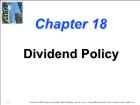 Bài giảng Financial Management - Chapter 18: Dividend Policy
Bài giảng Financial Management - Chapter 18: Dividend PolicyAfter Studying Chapter 18, you should be able to: Understand the dividend retention versus distribution dilemma faced by the firm. Explain the Modigliani and Miller (M&M) argument that dividends are irrelevant. Explain the counterarguments to M&M - that dividends do matter. Identify and discuss the factors affecting a firm's dividend and ret...
 44 trang | Chia sẻ: nguyenlinh90 | Ngày: 20/07/2019 | Lượt xem: 1024 | Lượt tải: 0
44 trang | Chia sẻ: nguyenlinh90 | Ngày: 20/07/2019 | Lượt xem: 1024 | Lượt tải: 0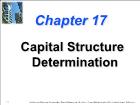 Bài giảng Financial Management - Chapter 17: Capital Structure Determination
Bài giảng Financial Management - Chapter 17: Capital Structure DeterminationAfter Studying Chapter 17, you should be able to: Define “capital structure.” Explain the net operating income (NOI) approach to capital structure and valuation of a firm; and, calculate a firm's value using this approach. Explain the traditional approach to capital structure and the valuation of a firm. Discuss the relationship between finan...
 43 trang | Chia sẻ: nguyenlinh90 | Ngày: 20/07/2019 | Lượt xem: 993 | Lượt tải: 0
43 trang | Chia sẻ: nguyenlinh90 | Ngày: 20/07/2019 | Lượt xem: 993 | Lượt tải: 0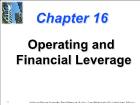 Bài giảng Financial Management - Chapter 16: Operating and Financial Leverage
Bài giảng Financial Management - Chapter 16: Operating and Financial LeverageAfter Studying Chapter 16, you should be able to: Define operating and financial leverage and identify causes of both. Calculate a firm’s operating break-even (quantity) point and break-even (sales) point . Define, calculate, and interpret a firm's degree of operating, financial, and total leverage. Understand EBIT-EPS break-even, or indiffe...
 64 trang | Chia sẻ: nguyenlinh90 | Ngày: 20/07/2019 | Lượt xem: 1068 | Lượt tải: 0
64 trang | Chia sẻ: nguyenlinh90 | Ngày: 20/07/2019 | Lượt xem: 1068 | Lượt tải: 0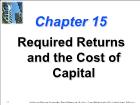 Bài giảng Financial Management - Chapter 15: Required Returns and the Cost of Capital
Bài giảng Financial Management - Chapter 15: Required Returns and the Cost of CapitalAfter Studying Chapter 15, you should be able to: Explain how a firm creates value and identify the key sources of value creation. Define the overall “cost of capital” of the firm. Calculate the costs of the individual components of a firm’s cost of capital - cost of debt, cost of preferred stock, and cost of equity. Explain and use alternati...
 51 trang | Chia sẻ: nguyenlinh90 | Ngày: 20/07/2019 | Lượt xem: 1154 | Lượt tải: 0
51 trang | Chia sẻ: nguyenlinh90 | Ngày: 20/07/2019 | Lượt xem: 1154 | Lượt tải: 0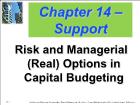 Bài giảng Financial Management - Chapter 14 – Support: Risk and Managerial (Real) Options in Capital Budgeting
Bài giảng Financial Management - Chapter 14 – Support: Risk and Managerial (Real) Options in Capital BudgetingSummary of Proposal A The standard deviation = SQRT (14,400,000) = $3,795 The expected cash flow = $5,000 Coefficient of Variation (CV) = $3,795 / $5,000 = 0.759 CV is a measure of relative risk and is the ratio of standard deviation to the mean of the distribution.
 14 trang | Chia sẻ: nguyenlinh90 | Ngày: 20/07/2019 | Lượt xem: 968 | Lượt tải: 0
14 trang | Chia sẻ: nguyenlinh90 | Ngày: 20/07/2019 | Lượt xem: 968 | Lượt tải: 0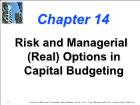 Bài giảng Financial Management - Chapter 14: Risk and Managerial (Real) Options in Capital Budgeting
Bài giảng Financial Management - Chapter 14: Risk and Managerial (Real) Options in Capital BudgetingAfter Studying Chapter 14, you should be able to: Define the "riskiness" of a capital investment project. Understand how cash-flow riskiness for a particular period is measured, including the concepts of expected value, standard deviation, and coefficient of variation. Describe methods for assessing total project risk, including a probability a...
 44 trang | Chia sẻ: nguyenlinh90 | Ngày: 20/07/2019 | Lượt xem: 985 | Lượt tải: 0
44 trang | Chia sẻ: nguyenlinh90 | Ngày: 20/07/2019 | Lượt xem: 985 | Lượt tải: 0
Website đang trong thời gian thử nghiệm, chờ xin giấy phép của Bộ TT & TT.

